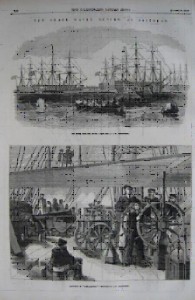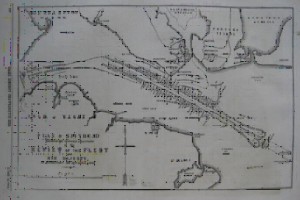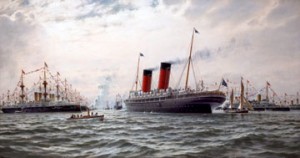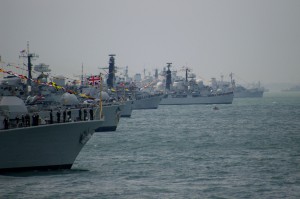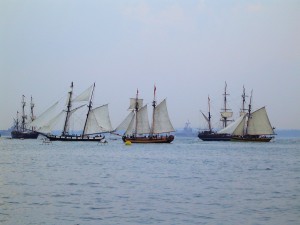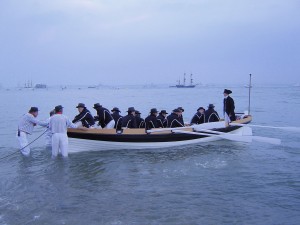The Fleet Reviews at Spithead
The townsfolk of Ryde will have witnessed many Fleet Reviews in The Solent at Spithead dating back as far as the 14th century. A Fleet Review is a British tradition where the monarch inspects the massed ships of the navy. It originally occurred when the fleet was mobilised for war, or for a ‘show of strength’ to discourage potential enemies. Since the 19th century reviews have often been held for the coronation of a monarch or for special royal jubilees and have often included delegates from other national navies.
Forty four naval reviews have been held to date and because they require a natural large, sheltered and deep anchorage, Spithead is an ideal place and is in full view of Ryde.
The first gathering of ships recorded was in June 1346 witnessed by Edward III before sailing to war with France, but the first acknowledged Fleet Review on record was in 1415 witnessed by Henry V before his first French campaign that ended in the Battle of Agincourt.
It was King George III who set the Fleet Review standards in 1773, by using the anchorage to display all ‘his’ ships, and the habit grew over the years as successive monarchs assembled larger and more impressive fleets for review.
The most reviews held during a monarch’s reign was during that of Queen Victoria when no less than 17 occurred, the first in March 1842 when the Queen is reported to have drunk a mess basin of grog, and liked it!
In April 1856 the first recorded evening illumination of the fleet took place. Over 100 gunboats were present. The Illustrated London News dated 26 April 1856 reported the event with paintings by maritime artist John Wilson Carmichael and a ‘Plan of the proposed elevations at the Review of the Fleet by Her Majesty Wednesday 23 April 1856’.
The Spithead Review of 1897 was reported as one of the great historical naval spectacles – a fleet of warships lined up in the greatest display of sea power the world had ever seen. The Campania, pride of the Cunard Fleet, along with several other famous merchant ships, attended the Review to accommodate the guests. The event was to mark Queen Victoria’s Diamond Jubilee – 60 years on the throne. The Queen was not feeling well enough to go to sea and her son Bertie, Prince of Wales and the future Edward VII, took her place. He was accompanied by guests from all over the British Empire and around the world.
It was claimed to be the largest number of warships ever gathered at anchor together. In two seven mile long lines between Portsmouth and the Isle of Wight, there were 170 British naval ships including 50 battleships. Nearly all were less than 10 years old and were immaculately ablaze with brass and bunting. Crews stood in ranks in wide straw hats and spotless white uniforms in the stunning spectacle.
In a publicity stunt, Charles Algernon Parsons brought his revolutionary turbine boat Turbinia uninvited to the Review. As the Prince of Wales, Lords of the Admiralty and other dignitaries looked on, Turbinia – much faster than anything else afloat – raced between the lines of big ships. She easily evaded the Royal Navy’s patrol boats. Parsons, who invented the steam turbine in 1884, had made a dramatic point and in 1905, the Admiralty confirmed all future Royal Naval ships would be turbine powered. The following year the first turbine-powered battleship, HMS Dreadnought, was launched.
There were 12 reviews in the twentieth century, the first taking place in 1909 for King Edward VII and the last in 1977 to celebrate Queen Elizabeth’s Silver Jubilee. In July 1914, 59 battleships and 17 seaplanes took part in the mobilisation of the fleet for World War One. The coronations of George VI and Elizabeth II were both celebrated with Fleet Reviews in the Solent but the planned 2002 Golden Jubilee Review was cancelled on cost grounds.
On Tuesday 28 June 2005, as part of the Bi-centenary celebrations for Trafalgar, a special International Review of the Fleet took place.
The Times reported “A vast armada of ships from all over the world lined up at Spithead today to mark the 200th anniversary of the Battle of Trafalgar and the death of Britain’s greatest naval hero, Admiral Lord Nelson. A total of 167 ships from the Royal Navy and 35 other nations moored along the Solent to be inspected by the Queen in the largest peace time international review in history.”
In the afternoon, it took about two hours for HMS Endurance to sail up and down the lines of anchored vessels, which the Queen inspected from on board. The fleet included warships, tall ships and representatives from all sectors of the marine industry from around the world. It was estimated 250,000 people watched from the shore and from a flotilla of yachts.
At 7pm, a son et lumiere mock Napoleonic sea battle was re-enacted by 17 tall ships from five nations, blazing cannon broadsides, gun smoke and state-of-the-art pyrotechnics.
The battle began when an actor playing the part of Nelson sailed from shore in a small cutter to board the tall ship the Grand Turk, a replica 19th century frigate. The ship played the part of Nelson’s historic flagship Victory during the battle. The mock Battle of Trafalgar was held between a blue and a red team, rather than Britain versus France, a decision that upset some who regarded it as unnecessary political correctness.
After the re-enactment, a massive fireworks display, one of the most spectacular ever staged in the UK, was mounted over the ships. The fleet was then illuminated for the remainder of the evening.
The celebrations culminated the following weekend in the International Festival of the Sea held at Portsmouth Dockyard, to mark the 200th anniversary of Nelson’s victory at Trafalgar.
Researched and written by Carol Strong and Janette Gregson.
Sources: http://news.bbc.co.uk, National Maritime Museum, Greenwich, London www.nmm.ac.uk, Illustrated London News www.iln.org.uk,Wikioedia http://en.wikipedia.org/wiki/Fleet_Review, www.btinternet.com/~philipr/Parsons, www.liverpoolmuseums.org.uk/maritime, www.battleships-cruisers.co.uk/fleet_reviews, www.times-archive.co.uk


